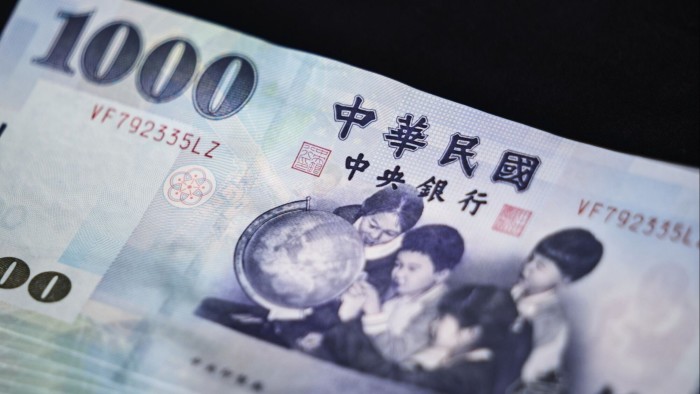Unlock the Editor’s Digest for free
Roula Khalaf, Editor of the FT, selects her favourite stories in this weekly newsletter.
Asian markets this week gave a lively taster of what a full-blown currency war might look like under Trump 2.0. But we are not at panic stations yet, and probably (touch wood) will not be any time soon.
It has, to be sure, been a week of high drama in a typically sleepy corner of markets. Seemingly out of nowhere, the Taiwanese dollar shot to the moon, jumping by, at the extremes, 10 per cent in two days. Even after calming down a little since, it is up by 6 per cent this month.
That was not all, however. The Hong Kong Monetary Authority has also intervened at the heaviest pace since 2020 to stop its currency from rising too far against its US cousin. Brace yourself, because any day now, the have-a-go heroes betting on a break in Hong Kong’s 42-year-old peg against the US currency will resurface. It is one of the most reliable widow-maker trades out there and so help them, the people who have tried and failed at it before will try and fail at it again. It’s always fun while it lasts though.
Of the two, it is the Taiwanese dollar that has caught the most market attention, and it is easy to extrapolate and catastrophise from here. One reason for that is the enormous amount of dollar exposure sitting with life insurers in Taiwan — around $700bn accumulated over the past decade, a third or so with no currency hedging. Those holders are now sitting on large paper losses.
The speed of the ascent in the Taiwanese currency is a legitimate cause for concern. Straight lines going up or down in markets charts, in pretty much any asset class, are a bad thing. It can take time for bodies to rise to the surface, but someone somewhere will always take a horrible hit and accidents can happen.
In addition, this can easily become self-fulfilling. Asian investors might, quite reasonably, feel unsettled by this currency blow and either sell dollar holdings outright, or hedge against further currency risk — an act that in itself helps to push the dollar further lower.
Stephen Jen at Eurizon SLJ Asset Management is among those warning of the theoretical risk that this could get ugly. In a note this week, he and his colleague Joana Freire said they reckoned Asian exporting nations had accumulated perhaps as much as $2.5tn in dollar hoardings since the pandemic five years ago. This creates what he calls “avalanche risk” for the dollar.
“Changes in the underlying macroeconomic conditions, such as yield differentials, relative fiscal positions, valuation, and geopolitical factors, could potentially trigger a non-linear sell-off in the dollar,” he said. “We continue to believe the risks of investors being blindsided by such a non-linear sell-off continue to rise.” It is a tail risk, but one worth taking seriously.
The other important thing here is the context. Donald Trump is clearly keen to seal deals on trade around the world, as this week’s agreement with the UK shows. Viewed through that lens, and especially with the desire in some parts of the administration for a weaker US dollar, the jump in the Taiwanese currency might well help to assuage some US concerns.
There have been signs that US administration might be distancing itself from the notion that Trump might seek to forge a grand international agreement to weaken the dollar globally and bolt defence and security guarantees on to US government bonds. The idea now seems dead on arrival given the risks to Treasuries and the focus on tariffs.
But the market is still sensitive about where currencies might fit in to trade deals. “There’s no direct evidence” that potential tariff talks was a factor here, said Shahab Jalinoos, a currencies analyst at UBS in New York. “But if the market believes something like that is a possibility, that could be disruptive” as investors and speculators of all stripes would try to get ahead of any agreement and shove markets around.
It is much more likely, Jalinoos said, that any Asian trade deals with the US will settle on vague assurances that countries are broadly supportive of, such as higher interest rates and somewhat stronger currencies, without pinpointing levels or timelines. That’s more manageable. It suggests slow and steady market adjustments. But canny communication — not exactly the US’s current strong suit — will be key to helping that happen.
So, “avalanches” and currency wars are the tail risks here. Unlikely, but worth bearing in mind, and potentially highly disruptive. If 2025 has taught us nothing else so far, it is to be ready for shocks.
The “everybody calm down” argument, though, is also pretty strong. Even after this week’s eye-popping ascent, the Taiwanese dollar is up by 8 per cent against the buck so far this year. So is the euro. Sure, Taiwan’s move happened in the blink of an eye, and that’s possibly not helpful, but this is just a catch-up. The US dollar’s broader descent is also, some scary moments aside, very orderly so far.
Second, the really big risks to the dollar remain the same: US geopolitical errors that lead to a sudden loss of confidence in the buck as the main global reserve currency, and US policy errors that create a recession and drag US interest rates down fast.
It is unlikely that Asia will cause a mess here. The US can still do that all by itself.
katie.martin@ft.com

